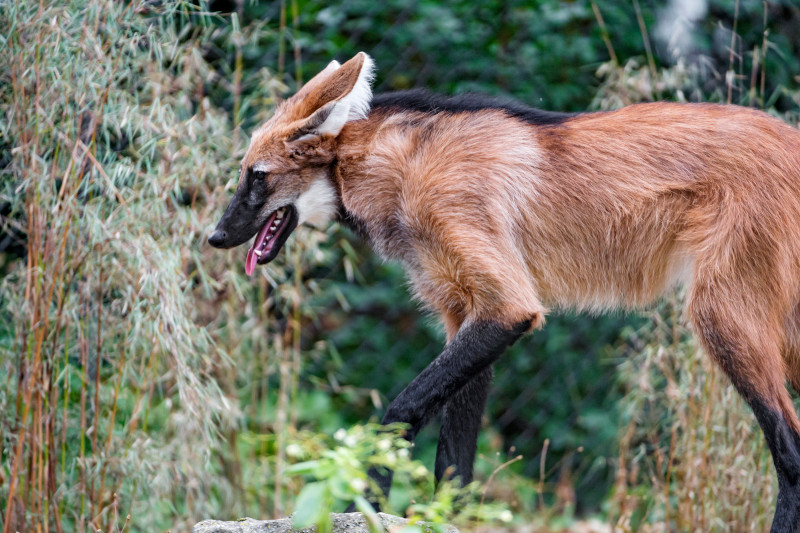
Maned Wolf Facts
- This highly distinctive product of Nature and evolution is most frequently referred to by the descriptive common name of Maned Wolf. It has a few other general titles, though. These include guara wolf, fruit wolf, skunk fox, and fox-on-stilts.
- Within the halls of science, however, it’s likely better known by its technical designation. Unfortunately, though, that’s an extremely difficult one for the layperson to pronounce. That’s because it holds the official moniker Chrysocyon brachyurus.
- The respected German zoologist Johann Karl Wilhelm Illiger recored the first recognition of it as a separate and distinct species. He achieved that scientifically noteworthy deed in 1815. He, however, assigned it the epithet of Canis brachyurus.
- Subsequent research later led to its renaming, though. In 1839, the noted English Charles Hamilton Smith assigned it the designation that it holds now. Still later, scientists considered reclassifying it again. But, for the moment, it remains as it is now.
- It’s well noted for several reasons, not just for its appearance. It represents the largest surviving wild canine in its part of the world. The animal also currently forms the only species in its Genus. But, it’s not a fox, wolf, jackal, or coyote, but a distinct canid.
- Regrettably, the population base of the amazing Maned Wolf seems to be diminishing. That unpleasant trend further appears to extend throughout its entire range. The IUCN therefore presently lists it as Near Threatened on its published Red List.
- This marvel faces mulitple threats to its continued existence as a species. Like all forms of life on earth today, most of those stem from the actions of mankind. They include deforestation, leading to habitat loss, and the ongoing effects of climate change.
Related Articles
Maned Wolf Physical Description
The remarkable Maned Wolf never fails to capture the attention and imagination of those fortunate enough to encounter it. Yet, the animal typically does so due more to its unusual appearance and physiology and size. In fact, it boasts several distinctive features.
Among these is an apparent fact based on an admittedly small sample group. That’s the fact that, in the few individuals science has managed to study, it displays little or no signs of the physiological characteristic of sexual dimorphism. That’s unusual in canines.
Mature adult specimens of both sexes thus display the same basic physical traits. The average adults stands approximately 43 in (1.1 m) tall at the shoulder. This mammal also achieves a mean weight of roughly 51 lb (23 kg). Exceptional examples appear to be few.
An average head-and-body length for the creature equals about 39 in (1 m). The tail, though, adds an additional 18 in (45 cm) on average. It also has extremely long ears, with a mean length of 7.1 in (18 cm). The long legs make it the tallest of all known wild canids.
The coloring of the Maned Wolf is another fascinating feature of the species. The primary background pattern varies from reddish-brown to an almost golden orange on the sides. It also displays a tuft of whitish fur at the tip of the tail, and under the throat.
The legs, though, display two colors. The upper section shows the same hues as the sides. The lower parts of each leg, meanwhile, present a deept black shade. But, it’s the presence of the namesake mane that garners the most attention. A dark black, this stands erect.
- Kingdom: Animalia
- Phylum: Chordata
- Class: Mammalia
- Order: Carnivora
- Family: Canidae
- Genus: Chrysocyon
- Species: C. brachyurus
Maned Wolf Distribution, Habitat, and Ecology
The fabulous Maned Wolf evolved as native to a moderately broad swathe of the surface of the earth. In fact, the full extent of that zone of habitation might surprise some people. That’s because it developed as endemic to a large portion of the continent of South America.
More precisely, the amazing product of evolution appears naturally in all but the most northerly sections of the landmass. That territory principally consists of the countries of Brazil, Paraguay, Bolivia, and Peru. Though still present, it’s almost extinct in Uruguay.
Like many of Nature’s wonders, the intrepid mammal displays decidedly strong and clear preferences regarding its choice of habitat. The animal exists within the region of the continent known as the cerrado. This region contains a variety of different ecosystems.
It appears in most of these. Some of the areas it inhabits include regions of both dry and wet forests, savannas, marshes, grasslands, and wetlands. Within this greater area, though, it prefers either open or semi-open habitats. It also favors the presence of scattered flora.
The Maned Wolf distinguishes itself from most other large wild canids in its behavior. That’s true since, rather than living in packs, it mainly lives a solitary existence. Individuals generally only gather to mate. It’s also mainly active at twilight, except on cloudy days.
The animal also evolved as omnivorous in terms of its diet. The fauna it consumes largely includes smaller species, such as rabbits, rodents, birds, and fish. Yet, it also eats plant matter, as well. That part of its diet includes tubers, roots, bulbs, and fruit, among others.
Species Sharing Its Range
Brazilian Wandering Spider
Check out our other articles on 3 Awesome Antarctic Land Species, Eastern Gray Squirrel, Cumberland Falls, Little Auk, Great Rhododendron, Oceanic whitetip shark, New Guinea Crocodile
